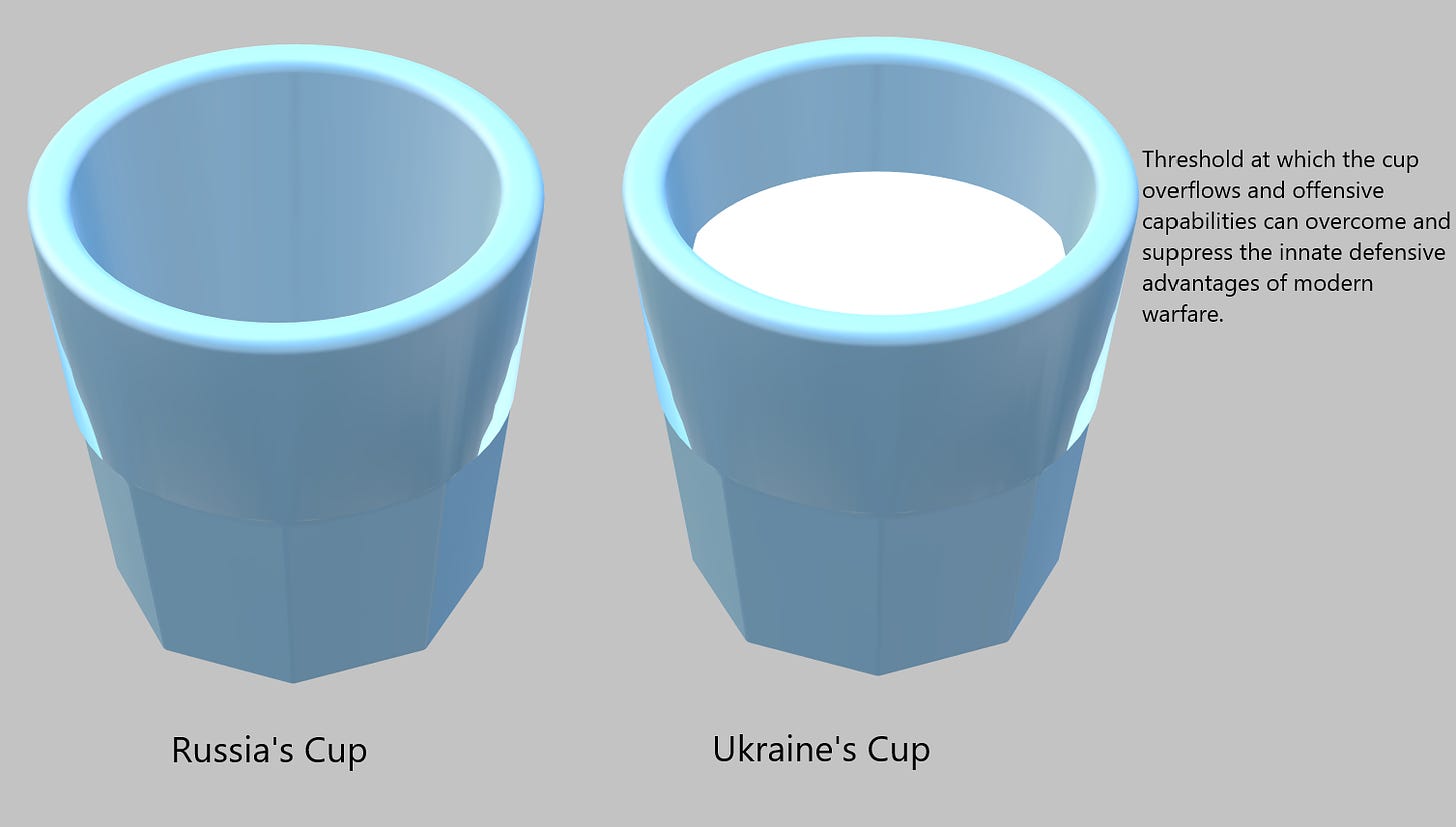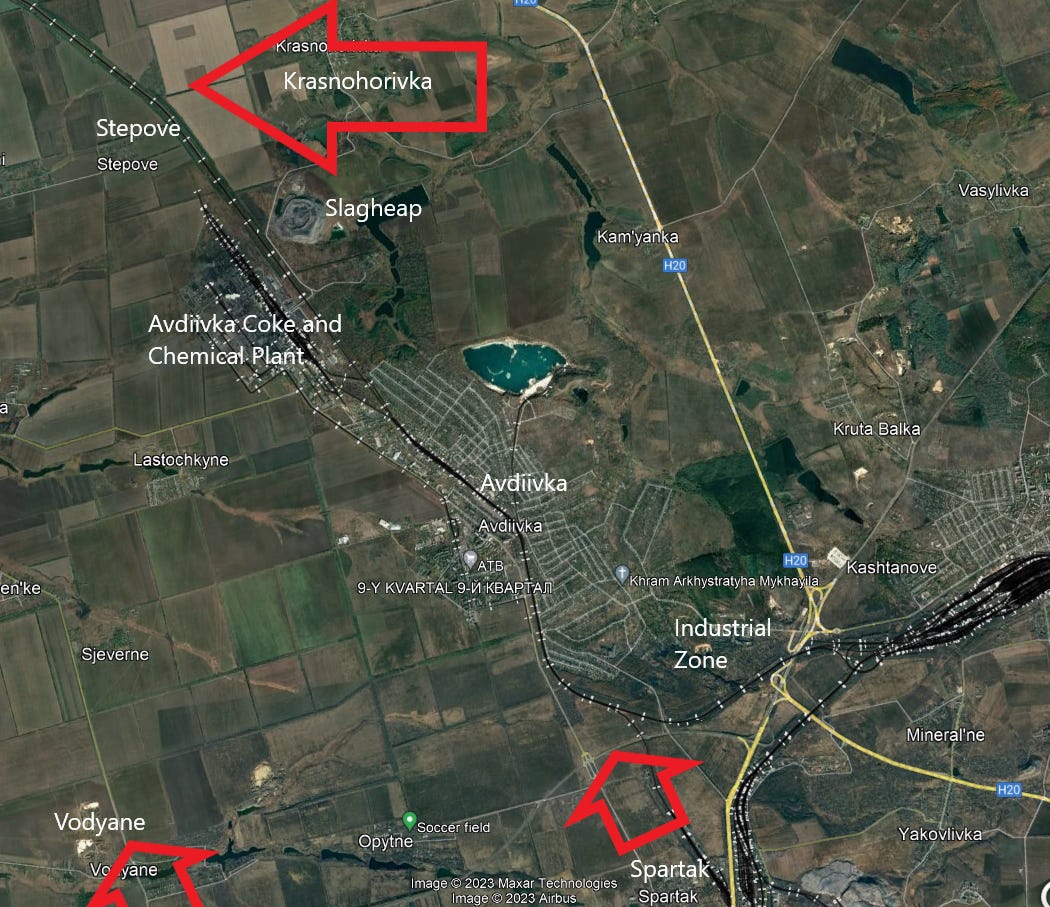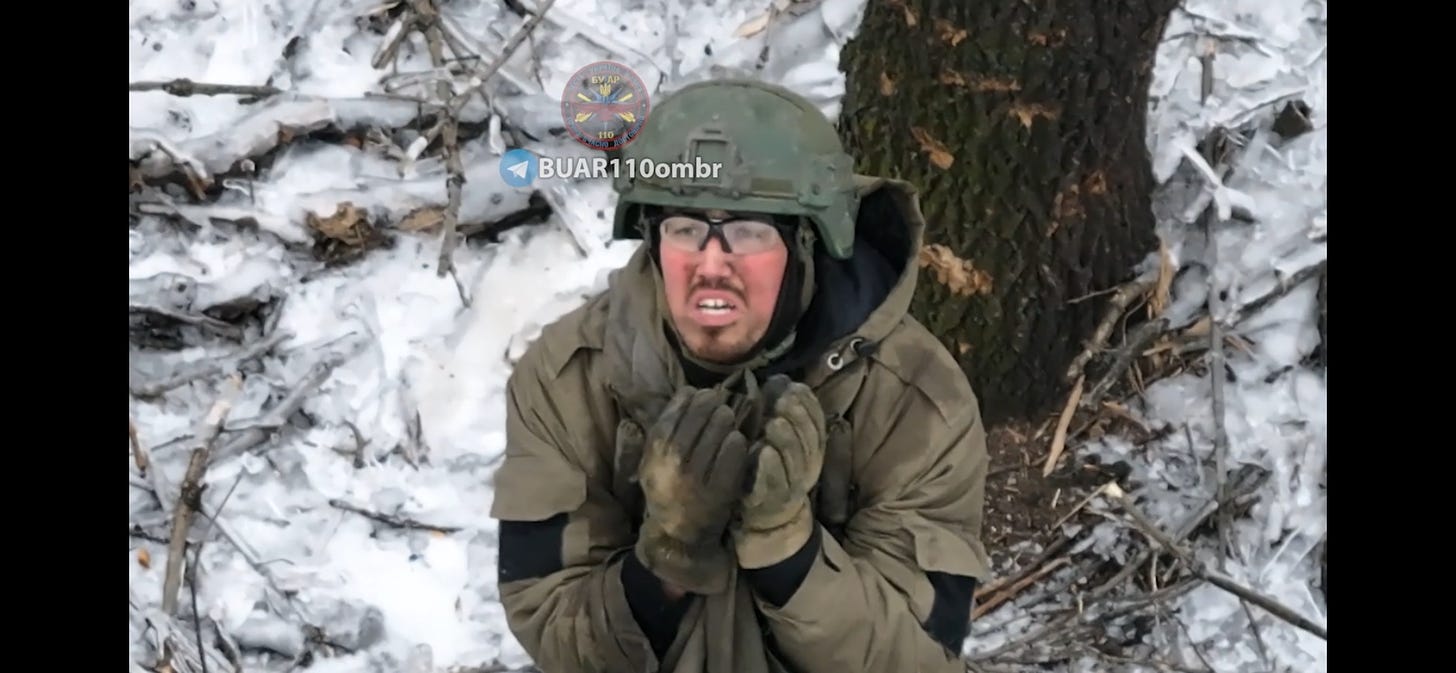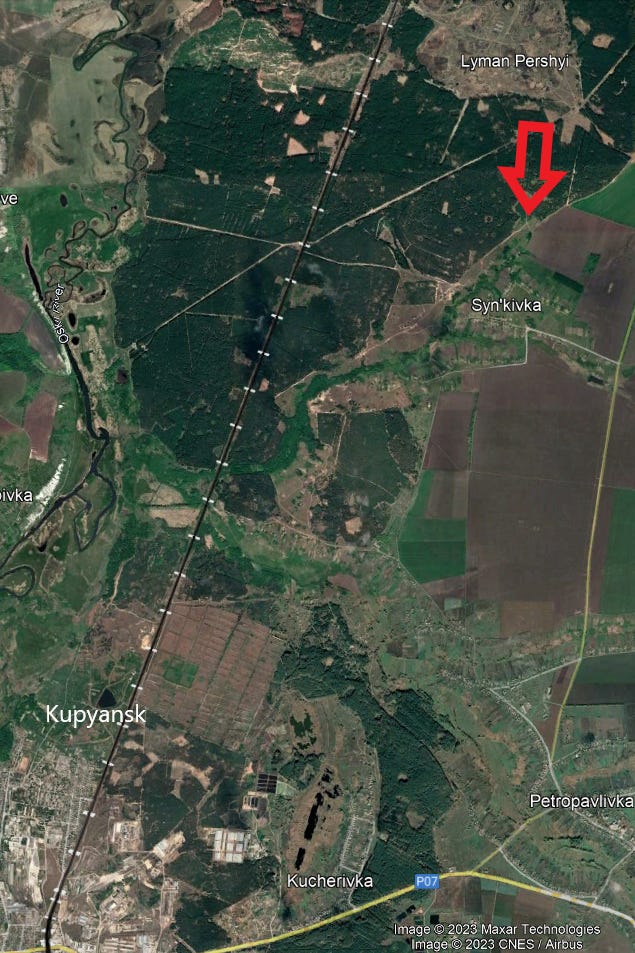TL;DR:
The Highs:
Beginning in early October, Russia launches attacks along the entire frontline, with their main effort being an attempt to encircle the garrison at Avdiivka. The city has been on the frontline and under Ukrainian control since the war began in 2014. The city and its environs are heavily fortified and an important strategic outpost in Ukraine’s defensive plan due to its proximity to Donetsk city.
Relentless massed mechanized and infantry assaults result in tens of thousands of Russians killed and hundreds of armored vehicles destroyed.
After losing nearly 200 armored vehicles — confirmed by open-source intelligence (OSINT) — Russia continues assaults with dismounted, poorly trained, and often poorly armed infantry — human wave tactics highly reminiscent of World War 1.
The Ukrainians cross the Dnipro River in Kherson oblast, occupying the marshes around Krynky with 400 marines backed up by artillery and drones, exploiting an organizational defect in the Russian military and preventing VDV, 58th CAA, and other units mauled during summer fighting from recovering combat strength.
Russia attempts several assaults near Synkivka with little success. The ineptitude of the mobiks conducting offensive operations here and near Avdiivka make clear Russia’s loss of offensive striking power.
The Lows:
Avdiivka is a grim battle. Despite holding firmly, the sense of bleakness and futility permeating the battlefield seeps into Western media’s perceptions of Ukraine’s ability to win the war.
A New York Times editorial writer pens an op-ed calling for Ukraine to cede territory and sit down for peace talks.
Republicans in the US House of Representatives begin holding military aid to Ukraine hostage in exchange for concessions relating to domestic border security, after the fall of former Speaker Kevin McCarthy, precipitated by right-wingers in his own party in September.
This about-face, denying aid to an ally in wartime, hands Putin one of his greatest hybrid war victories thus far. By the beginning of the new year, Ukraine is firing artillery shells at one-fifth its normal daily rate.
Some Ukrainian gains near Robotyne and Bakhmut are lost after worn-out elite units rotate off the line and are replaced by green units, especially amid the deepening ammunition shortages.
Avdiivka
Valerii Zaluzhnyi, Ukraine’s top general, published an essay detailing the current battlefield situation — one of stalemate — and listing the critical technologies and help that would allow Ukraine to overcome the innate advantage that defenders (in this case, Russians occupying Ukrainian territory) have in modern warfare. Western media seize on the word “stalemate”, interpreting it to mean a parity of competence and capability between the combatants. This is the wrong way to think about it. Instead, imagine two glasses that are exactly alike, but filled with different amounts of milk. In this analogy the point of overflowing is the point at which offensive power can suppress and overwhelm the innate advantage granted to defenders in modern warfare. Neither side is yet able attack and win — a stalemate — but while Ukraine’s glass needs a top-up, Russia has an empty cup, with a hole in the bottom.
Avdiivka is what happens when a broken cup tries to hold water.
The Russians begin by launching attacks near Vodyane to the south and Krasnohorivka to the north. On the 9th and 10th of October, long columns of Russian armored vehicles are spotted east of Krasnohorivka and south of Vodyane — meaning the columns were in some cases still 10 kilometers behind their own frontline when they first come under heavy artillery fire. By the time the survivors reach their “jumping-off” points and start attacking Ukrainian-held territory, few assault groups remain.
Despite this inauspicious start, Russian mechanized units press forward through the minefields, destroying Ukraine’s frontline positions with constant artillery bombardment, glide bombs, and kamikaze drones strikes. The Russians develop a deadly multiple-layer drone network over the battlefield. After a few weeks, the Yooks must abandon the Slagheap or “Terrikon”, a massive hill of mining refuse and dominant tactical height, although the Russians find that Ukrainian drones are equally capable of making the strategic overlook uninhabitable. As further evidence, Russia makes little headway near Vodyane throughout October and November. When the Russians also begin conducting assaults near Avdiivka’s industrial zone, the most effective tactic the Russian employ is to dig a tunnel up to the Ukrainian defenses, as was common in World War One, and catch the Yooks off-guard.
Within the Battle of Avdiivka, a particularly important conflict has been for control of a small village named Stepove. I highly recommend Don Hill’s three part series covering this fight. By December, partly due to heavy losses and partly due to mud, Russian armored vehicles are a rarity, and by the end of the year, exhausted Russian infantry only control about a third of Stepove. Outside of the industrial zone, almost no progress is made into Avdiivka itself, and after a few sporadic advances around Vodyane in December, battle lines have stabilized there, too. Even as Ukraine contends with severe ammunition shortages, Stepove has shown that Russian forces are too ill-trained to conduct effective offensive operations.
Another phenomenon is suicides on the battlefield by wounded Russian troops, which has been on the rise. State propaganda informs Russian audiences that Ukrainians mistreat prisoners of war, but my personal speculation is that it is common knowledge amongst mobiks that if they are wounded they will not receive prompt medical care. Faced with a lingering death from blood loss, more soldiers are opting to spare themselves that misery.
Western intelligence explicitly believes that Russia launches the offensive around Avdiivka to weaken Western support for Ukraine. With US aid to Ukraine in limbo, it is difficult to call it a total defeat. But after months of grinding combat, green mobiks have been spotted wandering no man’s land, or the “greyzone,” unarmed and weeping.
Others are gunned down without even realizing they have wandered into mortal danger. At the opening of the offensive, the sheer volume of Russians dying and armored vehicles exploding gave the impression of an inevitable onslaught, but now even former pro-Russian officers like Igor “Girkin” Strelkov acknowledge that Russia’s original offensive capabilities are completely spent.
To reinforce how important Western aid is to frontline troops, among the most iconic weapons in the fight for Avdiivka is the M2 Bradley fighting vehicle. The 47th Mechanized brigade – who captured Robotyne in August and are heavily equipped with donated Bradleys – rotated to Avdiivka to rest shortly before the first mechanized assaults commenced. As a result, numerous videos show these fighting vehicles providing deadly fire support, preventing Russian infantry from advancing in Stepove.
Krynky
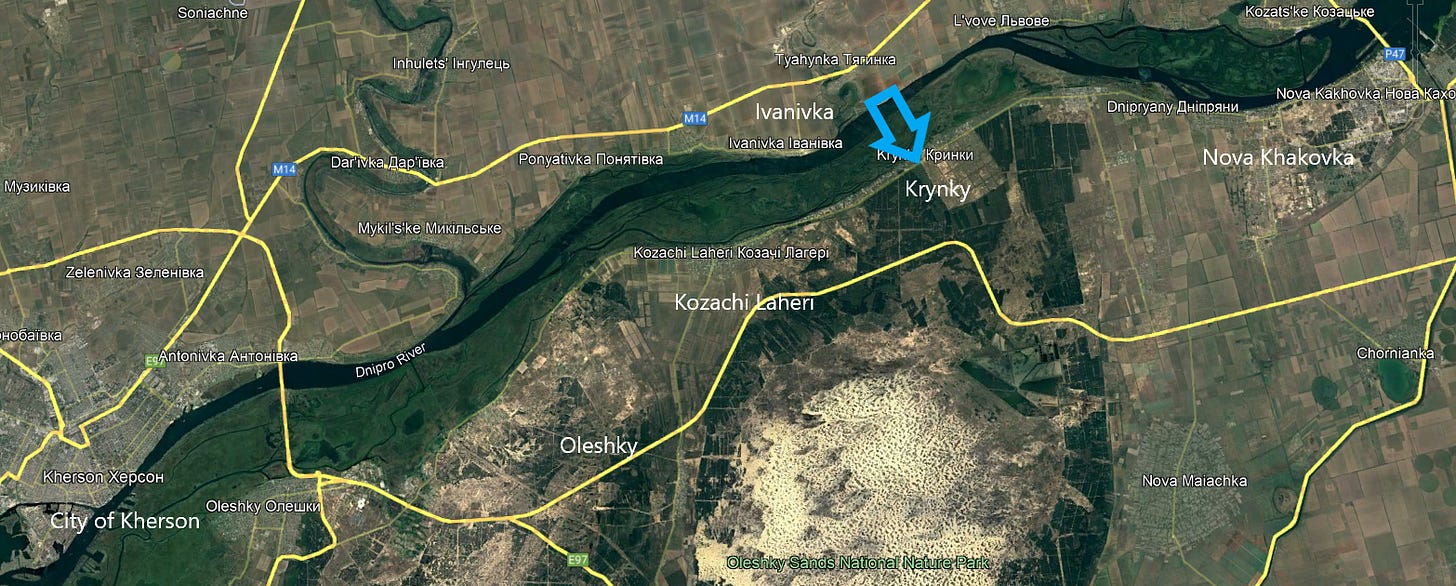
The ongoing Krynky operation is an attempt to achieve an economy of force. Using the 36th and 37th Naval Infantry (marine) brigades to cross the Dnipro River in inflatable boats, the Ukrainians managed to ferry 400 soldiers to establish a small bridgehead on the left (east) bank. Behind these marines are artillery and drone teams prepared to bring overwhelming firepower onto any targets that the 36th and 37th spot across the river. Supplies for the infantry are limited, since every bullet must be ferried on rafts, but extra attention is given to maintaining good stocks of kamikaze drones and artillery shells to allow constant pressure against the disorganized Russians.
The key to this operation is the structure — or lack thereof — of Russian forces in Kherson. In all other sectors, Russia’s military districts organize combat operations. This is a tried-and-true approach with which units are familiar and that carry a clear chain of command. During the 2023 Ukrainian Counteroffensive, badly damaged Russian fighting formations were sent to Kherson to recuperate, so the battalions and brigades fighting there tend to be both exhausted and piecemeal. Even worse, the lack of an overall command structure to coordinate between these battle-scarred units adds to a sense of chaos. The result has been thousands of Russian casualties and hundred more vehicles knocked out of commission.
Holding Krynky has been no picnic for Ukraine’s marines — who suffer in wet foxholes in the marshes, under constant bombardment and air strikes — but Russian units can no longer recover strength to be used elsewhere. Plus, the airspace above Krynky is so thick with Ukrainian drones that Russia is forced to resupply frontline positions on foot using unlucky runners.
Synkivka
As if the losses elsewhere were not bad enough, the Russians began launching equally suicidal attacks against the 30th Mechanized brigade defending the small village of Synkivka, located north of Kupyansk, near the border with Russia. At times, they managed to push Ukraine’s 30th back to the next treeline or row of houses, but for more than a month, 5 to 12 tanks and fighting vehicles, laden with ill-fated infantry, have trundled down the exact same road from Lyman Pershyi, sometimes past the wreckage of the last meat assault, until one by one the vehicles start exploding or are disabled by anti-tank guided missiles (ATGM) or mines.
The Russians do not have enough soldiers who know how to fight a modern war. Most of those who did are now maimed or dead.
2023 began with Russians seizing dozens of villages the size of Synkivka and Stepove in relentless advances north and south of Bakhmut. Looking even further back to 2022, Russia had the firepower to destroy entire cities – like Severodonetsk, Lysychansk, and Mariupol – and infantry to occupy the smoldering ruins. Now, Russia is hurrying civilians to the frontline with such speed that many are dying within weeks of leaving home.
That is the hole in Russia’s cup. Russia’s military capabilities have steadily declined over the course of this war, like a slow leak. With Krynky keeping badly damaged units from catching their breath, and battles like Avdiivka and Synkivka churning through mobiks faster than they can be trained, the Russian army cannot recover.
The West alone has the power to fill Ukraine’s glass to the brim, but inexplicably, the US Congress refuses. In 2023, Russia wasted its offense. Let us hope that in 2024, the US will not waste this chance to win.




